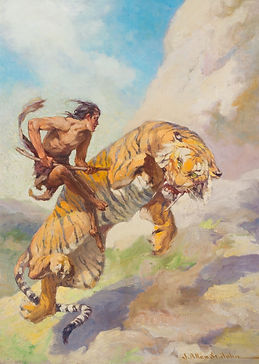J. Allen St. John
(American, 1872-1957)


An illustrator, art teacher, fine artist and author, J. Allen St. John left an indelible mark on the world of fantasy and adventure with his classical, dynamic compositions and elegant figures. He is regarded as one of the greatest of all heroic fantasy illustrators and the creator of this genre of art. He was a major influence on later, notable fantasy artists in the 1960s including Frank Frazetta and is still considered a grand master of fantasy by modern day artists.
St. John, the grandson of noted artist Hilliard Hely, inherited his grandfather’s artistic ability and began painting and drawing before he began to read and write. He traveled to Paris at the age of eight with his mother, also a talented artist, who let him wander through the Louvre and other major museums in Europe and instructed him in art. According to St. John, “My first recollections are my mother’s studio and the eyes of her portraits following me about the place.”
In stark contrast to his mother, St. John’s father was not supportive of his son’s artistic pursuits and instead encouraged him to become a merchant. At sixteen, St. John rebelled when his father bought him a partnership with an experienced businessman. As a result, St. John was sent to California to live on his uncle’s ranch where he learned to ride horses and work as a cowboy. While out west he befriended Eugene Torrey, a western artist, and after traveling and studying with Torrey for three years, St. John was determined to become an artist.
By the end of the 19th century, St. John moved to New York to enroll in the Art Students League and to become a society painter working on portraits and landscapes. By 1904, he had moved to Chicago and lived in a complex known as The Tree Studio, a building that combined living quarters with studio space. He lived there with his wife Ellen, until his death in 1957.
While in Chicago, at age forty, St. John decided to dedicate himself to a career in illustration, which he turned into a forty-five year career at numerous publishing companies in the city. He, however, never abandoned his fine art roots and taught painting and drawing at the Art Institute of Chicago for twenty years and later at the American Academy of Art.
One of St. John’s earliest illustrations was for the book The Return of Tarzan (1915) by Edgar Rice Burroughs, one of the most successful popular fiction writers of all time. St. John’s illustrations for Burroughs’ Tarzan, Mars and Pellucidar series of books included the full color book jackets, interior illustrations, and often the lettering for the title pages.
By the early 1930s, St. John’s name had become synonymous with Burroughs’ heroic tales. Burroughs once credited, “St. John added considerably to whatever success I have had… His visualization of the nightmare creatures of my imagination is truly remarkable.” Despite this fact and after thirty-six books together, Burroughs started his own publishing company in 1931 and stopped using St. John. He found St. John’s rates too high and wanted to employ the artistic talents of his own son.
After losing his best client, St. John moved on to do the covers Weird Tales and Magic Carpet magazines. He was eventually dropped from Weird Tales when the publisher decided to use artist Margaret Brundage’s sex-infused artwork for the covers, since those sold better than images of men and monsters. St. John remained industrious in the pulp genre during the 1940s and 1950s creating paintings for various magazines including those of editor Raymond Palmer such as Amazing Stories, Fate, and Other Worlds.
